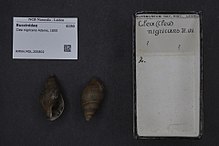| Clea nigricans | |
|---|---|

| |
| Clea nigricans shells | |
| Scientific classification | |
| Domain: | Eukaryota |
| Kingdom: | Animalia |
| Phylum: | Mollusca |
| Class: | Gastropoda |
| Subclass: | Caenogastropoda |
| Order: | Neogastropoda |
| Family: | Nassariidae |
| Genus: | Clea |
| Species: | C. nigricans |
| Binomial name | |
| Clea nigricans A. Adams, 1855 | |
| Synonyms | |
| |
Clea nigricans is a species of freshwater snail with an operculum, an aquatic gastropod mollusk in the family Buccinidae, the true whelks, most of which are marine.
Clea nigricans is the type species of the genus Clea.
Distribution
This Southeast Asian species occurs in the Malay Peninsula. It is found in member states Sabah and Sarawak on Borneo. It was recorded also from Sirhassen island in South Natuna Islands, Indonesia.
Description

The width of the shell is 5–12 mm. The height of the shell is 10–22 mm.
Ecology
It lives in calm pools of fast-flowing streams and also on rocks in small waterfalls. Polgar et al. (2015) measured thermal tolerance of Clea nigricans. The behaviour of Clea nigricans in natural habitat is unknown.
Feeding habits
Like all snails in the clade Neogastropoda, this species is carnivorous. It feeds on different types of worms and gastropods, often eating other, larger snails after burying themselves and ambushing their prey.
Life cycle
Clea nigricans consists of defined male and female genders, and is not capable of gender change. It is unknown as to how to sex these animals. Both males and females seem to be the same size and shape. When a male and female mate, they lock together for 8–12 hours.
References
- Adams A. (1855). "Description of two new genera and several new species of Mollusca, from the collection of Hugh Cuming, Esq". Proceedings of the Zoological Society of London 23: 119-124.
- Rosenberg, G. (2013). Clea nigricans A. Adams, 1855. In: MolluscaBase (2017). Accessed through: World Register of Marine Species at http://www.marinespecies.org/aphia.php?p=taxdetails&id=490903 on 2017-11-20
- ^ Monks, Neale (2009). "Assassin Snails and Sulawesi Elephant Snails: Keeping Clea and Tylomelania in the aquarium". Conscientious Aquarist Magazine. Retrieved March 11, 2014.
- Strong, E. E., Galindo, L. A., & Kantor, Y. I. (2017). "Quid est Clea helena? Evidence for a previously unrecognized radiation of assassin snails (Gastropoda: Buccinoidea: Nassariidae)". PeerJ 5: e3638. doi:10.7717/peerj.3638.
- ^ Polgar, G., Khang, T. F., Chua, T., & Marshall, D. J. (2015). "Gross mismatch between thermal tolerances and environmental temperatures in a tropical freshwater snail: climate warming and evolutionary implications". Journal of thermal biology 47: 99-108. doi:10.1016/j.jtherbio.2014.11.009.
- "Map of Clea nigricans". Discover Life. National Biological Information Infrastructure. Retrieved March 8, 2014.
| Taxon identifiers | |
|---|---|
| Clea nigricans | |
This Buccinidae-related article is a stub. You can help Misplaced Pages by expanding it. |